Green IoT: A Review and Future Research Directions
Abstract
1. Introduction
1.1. Background and Motivations
1.2. Related Works and Contributions
- A review of current research on the green IoT ecosystem, including recent industry developments and embedded systems, key areas of application, deployment, challenges, and key players focusing on RFID, WSN, processors, MCUs, and ICs.
- A discussion of key design choices and features for RFID and WSNs that are considered to be among the highest priorities within green IoT networks.
- An exploration of the limitations and challenges that need to be overcome to fully realize the potential of a green IoT, including issues related to interoperability, security, and privacy, and recommendations for future research to support the efforts in developing hardware for green IoT that promotes eco-sustainability.
1.3. Paper Organization
2. Methodology
- RQ1: What are the energy-efficient techniques that can be used to implement massive green IoT networks?
- RQ2: How can energy consumption be reduced in IoT devices without compromising performance and functionality?
- RQ3: What are the key challenges in designing and implementing green IoT networks?
3. Green Hardware IoT Framework
- Machine-to-Machine (M2M): M2M technology refers to the ability of smart devices to communicate with each other and exchange data without the need for human intervention. It forms the basis of IoT and allows for the creation of smart systems that can operate and make decisions independently [16]. One of the key applications of M2M technology is in the field of smart cities [11], where it can be used to optimize the performance of infrastructure such as traffic systems, public transportation, and utilities. M2M communication can also be utilized in industrial settings to improve efficiency and productivity, as well as in healthcare to enable remote monitoring and treatment of patients. In order to achieve energy efficiency in M2M systems, various strategies can be employed (as shown in Figure 3). These may include the use of low-power communication protocols, the implementation of energy-efficient protocols for data transmission, and energy-harvesting techniques to power M2M devices. Overall, M2M technology plays a crucial role in the advancement of the IoT and has the potential to substantially improve the efficiency and sustainability of a wide range of systems.
- Wireless Sensor Networks (WSNs): WSNs are networks of small, energy--efficient devices equipped with sensors that are capable of wirelessly communicating with each other and with a central hub. WSNs can be used to monitor and collect data from various environments and are commonly deployed in a broad range of applications, including industrial monitoring, healthcare, and environmental monitoring. In order to make WSNs more energy-efficient, various strategies can be employed. These may include the use of energy-efficient communication protocols, the implementation of energy-harvesting techniques to power the sensors, and the use of energy-efficient storage and data processing methods (as depicted in Figure 3). One promising research context in the field of WSNs is the use of machine learning algorithms to improve energy efficiency. These algorithms can be applied to streamline data transmission and lower the overall network energy usage. Overall, WSNs have the potential to greatly boost efficiency and sustainability and will likely continue to be an important area of research in the field of IoT [17].
- Radio-Frequency Identification (RFID): RFID is a wireless technology that identifies and tracks objects using radio waves. It consists of a small chip, known as an RFID tag, which is associated with an object and a reader that is able to detect and communicate with the tag. RFID technology has a wide range of applications, including inventory tracking, supply chain management, and asset management. The technologies for improving energy efficiency may include the use of low-power communication protocols, the implementation of energy-efficient data processing techniques, and the use of energy-harvesting methods to power RFID devices. One promising area of research in the field of RFID is the development of passive RFID tags, which do not require an energy source and can operate indefinitely as long as they are within range of an RFID reader [18].
- Microcontroller Units (MCUs) and Integrated Circuits (ICs): MCUs and ICs are key components of many electronic devices, including those used in the IoT. MCUs are small computers that are used to control and monitor the operation of a device, while ICs are electronic circuits that are used to process and transmit information. The strategies for enhancing the energy efficiency of MCUs and ICs may include the use of low-power design techniques, the implementation of energy-efficient data processing algorithms, and the incorporation of energy-harvesting methods to power the devices. One promising area of research in the field of MCUs and ICs is the use of ML algorithms to optimize their performance and reduce energy consumption [19]. Another area of focus is the emergence of more energy-efficient materials and intelligent manufacturing processes for these devices.
4. Energy-Efficient M2M Communications
4.1. Energy-Efficient Data Transmission
- (i)
- Data compression: Compressing data before transmission can reduce the amount of energy used to transmit it. Data compression techniques that are straightforward to use and have low computational requirements often use less energy [20]. However, the balance between the amount of data that is compressed and the energy needed can be complex, as techniques that compress data more may require more energy [21]. Table 1 provides a summary of data compression techniques, highlighting their respective advantages and disadvantages. Based on information from existing reviews or research in the field [22,23,24], these factors were determined by the authors of this article.
- (ii)
- (iii)
- ML algorithms: ML algorithms can be used to minimize data redundancy and optimize the rate of data transmission in multicell networks. The type of algorithm depends on the specific needs of the M2M application, including the amount and complexity of available data and the required accuracy. Testing different algorithms and evaluating their performance can help determine the most suitable one for a specific M2M application [31,32,33,34].
- (iv)
- Power control: By carefully adjusting the transmission power of M2M devices, it is possible to reduce the energy required for data transmission. There are several techniques that can be implemented to control power and improve energy efficiency performance in M2M data transmission, such as power-aware routing, adaptive modulation and coding, and duty cycling [35].
- (v)
- Energy-efficient protocols: There are numerous communication protocols that have been designed specifically to improve the EE of data transmission in a green M2M network. However, each of these protocols has its own unique set of advantages and disadvantages, and the most suitable protocol can be chosen based on the specific requirements of the M2M application. Details of the transmission protocols and technologies are discussed in the following sections.
4.2. Power-Aware Scheduling
4.3. Offloading Computation/Task Offloading
- (i)
- Edge-based offloading: In this type of offloading, computation-intensive tasks are transferred to a nearby edge device, such as a gateway or a fog node. This can be done over a local area network (LAN) or a wireless network.
- (ii)
- Fog-based offloading: A decentralized computing paradigm that gathers computing and data storage closer to the devices and users that need them, enabling more efficient and effective use of resources.
- (iii)
- Cloud-based offloading: In this type of offloading, computation-intensive tasks are transferred to a remote server or cloud computing infrastructure. This can be done over the internet or a wide area network (WAN).
- (i)
- Data-intensive offloading: In this type of offloading, tasks that involve large amounts of data, such as data analysis and machine learning, are transferred to external resources.
- (ii)
- Computation-intensive offloading: In this type of offloading, tasks that require significant processing power, such as image processing and video encoding, are transferred to external resources.
4.4. Energy-Efficient Hardware
- (i)
- Energy-efficient sensors (Green WSNs): Some sensors including, temperature and humidity sensors, are known to be very power-hungry devices. Therefore, using energy-efficient sensors is the best way to reduce the power consumption in M2M systems. Details are given in Section 5.
- (ii)
- Energy-efficient radios (Green RFID): Radio transceivers are a major source of power consumption in M2M devices. Thus, using an energy-efficient radio can improve the power consumption in M2M networks. Details are given in Section 5.
- (iii)
- Low-power microprocessors (Green MCUs and ICs): By using a low-power microprocessor, the overall power expenditure of an M2M device can be considerably reduced. Details are presented in Section 6.
5. Energy-Efficient and Eco-Sustainable Wireless Sensor Networks
5.1. Radio Optimization Techniques
5.2. Sleep/Wake-Up Techniques
5.3. Energy Harvesting, Batteries, and Wireless Charging Techniques
5.3.1. Energy Harvesting Sources
5.3.2. Battery Technologies for IoT/Sensor Devices
5.3.3. Wireless Charging Techniques
- The non-directive RF radiation technique uses electromagnetic radiation in the radio frequency range between 300 GHz and 3 kHz to transmit electric energy. This method is well suited for far-field communication; however, it has low efficiency in converting RF energy to DC energy when the harvested RF power is low. For further details on this technique and other RF power transfer methods, readers can refer to [62,63].
- Magnetic resonance coupling involves the utilization of an evanescent field that generates and transmits electrical energy between two resonators [65]. To create this type of resonator, a capacitance is inserted between an induction coil. An illustration of the operating concept is depicted in Figure 8.
5.4. Energy-Efficient WSN Architecture and Routing Protocols
- It decreases the communication distance within the cluster, which reduces the need for high transmission power.
- It reduces the number of transmissions by leveraging data fusion at the cluster head.
- It cuts down energy-consuming activities such as coordination and data aggregation by distributing them to the cluster head.
- It allows for some nodes to be powered off within the cluster, as the cluster head assumes forwarding responsibilities.
- It distributes energy consumption evenly among nodes by rotating the cluster head position.
5.5. Aggregation and Reduction of the Data
6. Energy-Efficient Radio-Frequency Identification
6.1. Passive RFID Systems
6.2. Active RFID Systems
- Batteries: Batteries have been a popular power source for various devices since their invention and are still widely used today. However, they have a short lifespan and must be replaced after a certain period. Even rechargeable batteries lose their energy-retaining capabilities over time. Another important factor to consider when choosing a storage device is the form factor, which refers to the shape and size of the device. However, the relationship between form factor and capacity is often conflicting, as a larger capacity often means a larger device size [111]. As a result, batteries may not be the best option for RFID environments, where a small and flexible device is needed. Research has been conducted to find ways to develop compact energy storage devices that offer more flexibility while maintaining a high capacity. The emergence of thin film technology has made it possible for batteries to have the form factor needed for RFID applications [112]. This technology allows for the creation of electronic devices that are paper-thin and recognized as well-matched for thermo-electric micro-systems. Studies have shown that thin-film batteries are an ideal choice for applications where a thermal difference is present, such as the human body [113]. Overall, thin-film technology offers versatility and is a promising option for RFID tags.
- Capacitors: Capacitors are highly energy-efficient storage devices and do not diminish their capacity quickly, making them an ideal component for certain applications. However, the capacity of a capacitor is largely dependent on its size, and so capacitors often sacrifice form factors for a longer lifespan. Additionally, capacitors are unreliable to some extent because they are extremely susceptible to changes in current and voltage. However, recent advancements in capacitor storage technology have led to the development of ultra-capacitors and super-capacitors, which can store large amounts of energy and combine the reliability and performance of rechargeable batteries with the longevity of regular capacitors [114]. These ultra-capacitors are selected by designers because they have high energy densities that are many orders of magnitude higher than those of conventional capacitors. Some designs deploy a combination of storage devices, creating a hybrid system that combines the best features of different devices. These models have been investigated and tested using solar-powered wireless sensors with promising results [115]. The “Prometheus” model, for example, uses a dual-stage storage model in conjunction with a super-capacitor in the first stage and a lithium ion rechargeable battery in the second stage [116]. This system is regarded as a buffer for powering a Berkeley Telos mote extracted from a PV solar panel system, and experimental results have shown that it can run for up to 43 years at a 1% load and up to 1 year at a 100% load.
7. Energy-Efficient Microcontroller Units and Integrated Circuits
8. Potential Future Directions
- (i)
- Zero energy
- (ii)
- Routing schemes
- (iii)
- Adaptive AI and ML
- (iv)
- Intelligent sleep modes
- (v)
- Wireless charging
9. Conclusions
Author Contributions
Funding
Institutional Review Board Statement
Informed Consent Statement
Data Availability Statement
Conflicts of Interest
References
- Al-Fuqaha, A.; Guizani, M.; Mohammadi, M.; Aledhari, M.; Ayyash, M. Internet of things: A survey on enabling technologies, protocols, and applications. IEEE Commun. Surv. Tutor. 2015, 17, 2347–2376. [Google Scholar] [CrossRef]
- AArshad, R.; Zahoor, S.; Shah, M.A.; Wahid, A.; Yu, H. Green IoT: An Investigation on Energy Saving Practices for 2020 and Beyond. IEEE Access 2017, 5, 15667–15681. [Google Scholar] [CrossRef]
- Zanella, A.; Bui, N.; Castellani, A.; Vangelista, L.; Zorzi, M. Internet of things for smart cities. IEEE Internet Things J. 2014, 1, 22–32. [Google Scholar] [CrossRef]
- Almotiri, S.H.; Khan, M.A.; Alghamdi, M.A. Mobile health (m-health) system in the context of IoT. In Proceedings of the 4th International Conference on Future Internet of Things and Cloud Workshops (FiCloudW), Vienna, Austria, 22–24 August 2016; pp. 39–42. [Google Scholar]
- Alsharif, M.H.; Nordin, R. Evolution towards fifth generation (5G) wireless networks: Current trends and challenges in the deployment of millimetre wave, massive MIMO, and small cells. Telecommun. Syst. 2017, 64, 617–637. [Google Scholar] [CrossRef]
- Lee, C.-S.; Kim, D.-H.; Kim, J.-D. An energy efficient active RFID protocol to avoid overhearing problem. IEEE Sens. J. 2014, 14, 15–24. [Google Scholar] [CrossRef]
- Tsai, C.-W.; Lai, C.-F.; Chiang, M.-C.; Yang, L.T. Data Mining for Internet of Things: A Survey. IEEE Commun. Surv. Tutor. 2013, 16, 77–97. [Google Scholar] [CrossRef]
- He, M.; Forootan Fard, H.; Yahya, K.; Mohamed, M.; Alhamrouni, I.; Awalin, L.J. Optimal Design of Hybrid Renewable Systems, Including Grid, PV, Bio Generator, Diesel Generator, and Battery. Sustainability 2023, 15, 3297. [Google Scholar] [CrossRef]
- Alsharif, M.H. Techno-Economic Evaluation of a Stand-Alone Power System Based on Solar Power/Batteries for Global System for Mobile Communications Base Stations. Energies 2017, 10, 392. [Google Scholar] [CrossRef]
- Albreem, M.A.; Sheikh, A.M.; Alsharif, M.H.; Jusoh, M.; Yasin, M.N. Green Internet of Things (GIoT): Applications, practices, awareness, and challenges. IEEE Access 2021, 9, 38833–38858. [Google Scholar] [CrossRef]
- Alsharif, M.H.; Nordin, R.; Ismail, M. Classification, Recent Advances and Research Challenges in Energy Efficient Cellular Networks. Wirel. Pers. Commun. 2014, 77, 1249–1269. [Google Scholar] [CrossRef]
- Miorandi, D.; Sicari, S.; De Pellegrini, F.; Chlamtac, I. Internet of things: Vision, applications and research challenges. Ad. Hoc. Netw. 2012, 10, 1497–1516. [Google Scholar] [CrossRef]
- Baliga, J.; Ayre, R.W.; Hinton, K.; Tucker, R.S. Green cloud computing: Balancing energy in processing, storage, and transport. Proc. IEEE 2011, 99, 149–167. [Google Scholar] [CrossRef]
- Shaikh, F.K.; Zeadally, S. Energy harvesting in wireless sensor networks: A comprehensive review. Renew. Sustain. Energy Rev. 2016, 55, 1041–1054. [Google Scholar] [CrossRef]
- Akkaya, K.; Guvenc, I.; Aygun, R.; Pala, N.; Kadri, A. IoT-based occupancy monitoring techniques for energy-efficient smart buildings. In Proceedings of the 2015 IEEE Wireless Communications and Networking Conference Workshops (WCNCW 2015), New Orleans, LA, USA, 9–12 March 2015; pp. 58–63. [Google Scholar]
- Höller, J.; Boyle, D.; Karnouskos, S.; Avesand, S.; Mulligan, C.; Tsiatsis, V. From Machine-to-Machine to the Internet of Things; Elsevier: Amsterdam, The Netherlands, 2014. [Google Scholar]
- Gulati, K.; Boddu, R.S.K.; Kapila, D.; Bangare, S.L.; Chandnani, N.; Saravanan, G. A review paper on wireless sensor network techniques in Internet of Things (IoT). Mater. Today Proc. 2021, 51, 161–165. [Google Scholar] [CrossRef]
- Al-Turjman, F.; Kamal, A.; Rehmani, M.H.; Radwan, A.; Pathan, A.-S.K. The green internet of things (g-iot). Hindawi 2019, 2019, 6059343. [Google Scholar] [CrossRef]
- Wang, X.; Magno, M.; Cavigelli, L.; Benini, L. FANN-on-MCU: An Open-Source Toolkit for Energy-Efficient Neural Network Inference at the Edge of the Internet of Things. IEEE Internet Things J. 2020, 7, 4403–4417. [Google Scholar] [CrossRef]
- Azar, J.; Makhoul, A.; Barhamgi, M.; Couturier, R. An energy efficient IoT data compression approach for edge machine learning. Futur. Gener. Comput. Syst. 2019, 96, 168–175. [Google Scholar] [CrossRef]
- Deepu, C.J.; Heng, C.-H.; Lian, Y. A Hybrid Data Compression Scheme for Power Reduction in Wireless Sensors for IoT. IEEE Trans. Biomed. Circuits Syst. 2016, 11, 245–254. [Google Scholar] [CrossRef]
- Biagetti, G.; Crippa, P.; Falaschetti, L.; Mansour, A.; Turchetti, C. Energy and Performance Analysis of Lossless Compression Algorithms for Wireless EMG Sensors. Sensors 2021, 21, 5160. [Google Scholar] [CrossRef]
- Ketshabetswe, K.L.; Zungeru, A.M.; Mtengi, B.; Lebekwe, C.K.; Prabaharan, S.R.S. Data Compression Algorithms for Wireless Sensor Networks: A Review and Comparison. IEEE Access 2021, 9, 136872–136891. [Google Scholar] [CrossRef]
- Shivaprakasha, S.P.K. Energy-efficient communication using data aggregation and data compression techniques in wireless sensor networks: A survey. In Advances in Communication, Signal Processing, VLSI, and Embedded Systems: Select Proceedings of VSPICE 2019; Springer: Berlin/Heidelberg, Germany, 2020; pp. 161–179. [Google Scholar]
- Zheng, J.; Wang, P.; Li, C. Distributed Data Aggregation Using Slepian–Wolf Coding in Cluster-Based Wireless Sensor Networks. IEEE Trans. Veh. Technol. 2010, 59, 2564–2574. [Google Scholar] [CrossRef]
- Vuran, M.; Akyildiz, I. Spatial correlation-based collaborative medium access control in wireless sensor networks. IEEE/ACM Trans. Netw. 2006, 14, 316–329. [Google Scholar] [CrossRef]
- Alsharif, M.H.; Nordin, R.; Ismail, M. Survey of Green Radio Communications Networks: Techniques and Recent Advances. J. Comput. Netw. Commun. 2013, 2013, 1–13. [Google Scholar] [CrossRef]
- Bartoli, A.; Dohler, M.; Hernández-Serrano, J.; Kountouris, A.; Barthel, D. Low-power low-rate goes long-range: The case for secure and cooperative machine-to-machine communications. In Proceedings of the International Conference on Research in Networking, Valencia, Spain, 9–13 May 2011; pp. 219–230. [Google Scholar]
- Tu, C.-Y.; Ho, C.-Y.; Huang, C.-Y. Energy-efficient algorithms and evaluations for massive access management in cellular based machine to machine communications. In Proceedings of the 2011 IEEE Vehicular Technology Conference (VTC Fall), San Francisco, CA, USA, 5–8 September 2011; pp. 1–5. [Google Scholar]
- Himsoon, T.; Siriwongpairat, W.P.; Han, Z.; Liu, K.R. Lifetime maximization via cooperative nodes and relay deployment in wireless networks. IEEE J. Sel. Areas Commun. 2007, 25, 306–317. [Google Scholar] [CrossRef]
- Alsharif, M.H.; Kelechi, A.H.; Yahya, K.; Chaudhry, S.A. Machine Learning Algorithms for Smart Data Analysis in Internet of Things Environment: Taxonomies and Research Trends. Symmetry 2020, 12, 88. [Google Scholar] [CrossRef]
- Beferull-Lozano, R.C.B. Lossy network correlated data gathering with high-resolution coding. IEEE Trans. Inf. Theory 2006, 52, 2817–2824. [Google Scholar]
- Yuen, K.; Liang, B.; Li, B. A distributed framework for correlated data gathering in sensor networks. IEEE Trans. Veh. Technol. 2008, 57, 578–593. [Google Scholar] [CrossRef]
- Bandari, D.; Pottie, G.J.; Frossard, P. Correlation-Aware Resource Allocation in Multi-Cell Networks. IEEE Trans. Wirel. Commun. 2012, 11, 4438–4445. [Google Scholar] [CrossRef]
- Kozłowski, A.; Sosnowski, J. Energy Efficiency Trade-Off Between Duty-Cycling and Wake-Up Radio Techniques in IoT Networks. Wirel. Pers. Commun. 2019, 107, 1951–1971. [Google Scholar] [CrossRef]
- El-Hosseini, M.; ZainEldin, H.; Arafat, H.; Badawy, M. A fire detection model based on power-aware scheduling for IoT-sensors in smart cities with partial coverage. J. Ambient. Intell. Humaniz. Comput. 2021, 12, 2629–2648. [Google Scholar] [CrossRef]
- Atzori, L.; Bellido, J.; Bolla, R.; Genovese, G.; Iera, A.; Jara, A.; Lombardo, C.; Morabito, G. SDN&NFV contribution to IoT objects virtualization. Comput. Netw. 2018, 149, 200–212. [Google Scholar]
- Aucinas, A.; Crowcroft, J.; Hui, P. Energy efficient mobile M2M communications. In Proceedings of the 4th Extreme Conference on Communication, Zurich, Switzerland, 10–14 March 2012; Volume 12. [Google Scholar]
- Heidari, A.; Jamali, M.A.J.; Navimipour, N.J.; Akbarpour, S. Internet of things offloading: Ongoing issues, opportunities, and future challenges. Int. J. Commun. Syst. 2020, 33, e4474. [Google Scholar] [CrossRef]
- Mao, Q.; Hu, F.; Hao, Q. Deep Learning for Intelligent Wireless Networks: A Comprehensive Survey. IEEE Commun. Surv. Tutor. 2018, 20, 2595–2621. [Google Scholar] [CrossRef]
- Durand, T.G.; Visagie, L.; Booysen, M.J. Evaluation of next-generation low-power communication technology to replace GSM in IoT-applications. IET Commun. 2019, 13, 2533–2540. [Google Scholar] [CrossRef]
- Poursafar, N.; Alahi, M.; Mukhopadhyay, S. Long-range wireless technologies for IoT applications: A review. In Proceedings of the 2017 Eleventh International Conference on Sensing Technology (ICST), Sydney, Australia, 4–6 December 2017; pp. 1–6. [Google Scholar]
- Bahashwan, A.A.; Anbar, M.; Abdullah, N.; Al-Hadhrami, T.; Hanshi, S. Review on common IoT communication technologies for both long-range network (LPWAN) and short-range network. In Advances on Smart and Soft Computing: Proceedings of ICACIn 2020; Springer: Berlin/Heidelberg, Germany, 2021; pp. 341–353. [Google Scholar]
- Rault, T.; Bouabdallah, A.; Challal, Y. Energy efficiency in wireless sensor networks: A top-down survey. Comput. Netw. 2014, 67, 104–122. [Google Scholar] [CrossRef]
- Lin, S.; Miao, F.; Zhang, J.; Zhou, G.; Gu, L.; He, T.; Stankovic, J.A.; Son, S.; Pappas, G.J. ATPC: Adaptive transmission power control for wireless sensor networks. ACM Trans. Sens. Netw. 2016, 12, 6. [Google Scholar] [CrossRef]
- Correia, L.H.; Macedo, D.F.; dos Santos, A.L.; Loureiro, A.A.; Nogueira, J.M.S. Transmission power control techniques for wireless sensor networks. Comput. Netw. 2007, 51, 4765–4779. [Google Scholar] [CrossRef]
- Chu, X.; Sethu, H. Cooperative Topology Control with Adaptation for improved lifetime in wireless sensor networks. Ad. Hoc. Netw. 2015, 30, 99–114. [Google Scholar] [CrossRef]
- Cui, S.; Goldsmith, A.; Bahai, A. Energy-Efficiency of MIMO and Cooperative MIMO Techniques in Sensor Networks. IEEE J. Sel. Areas Commun. 2004, 22, 1089–1098. [Google Scholar] [CrossRef]
- Jayaweera, S. Virtual MIMO-based cooperative communication for energy-constrained wireless sensor networks. IEEE Trans. Wirel. Commun. 2006, 5, 984–989. [Google Scholar] [CrossRef]
- Cui, S.; Goldsmith, A.J.; Bahai, A. Energy-constrained modulation optimization. IEEE Trans. Wirel. Commun. 2005, 4, 2349–2360. [Google Scholar]
- Costa, F.M.; Ochiai, H. A comparison of modulations for energy optimization in wireless sensor network links. In Proceedings of the 2010 IEEE Global Telecommunications Conference (GLOBECOM 2010), Miami, FL, USA, 6–10 December 2010; pp. 1–5. [Google Scholar]
- Misra, S.; Kumar, M.P.; Obaidat, M.S. Connectivity preserving localized coverage algorithm for area monitoring using wireless sensor networks. Comput. Commun. 2011, 34, 1484–1496. [Google Scholar] [CrossRef]
- Karasabun, E.; Korpeoglu, I.; Aykanat, C. Active node determination for correlated data gathering in wireless sensor networks. Comput. Netw. 2013, 57, 1124–1138. [Google Scholar] [CrossRef]
- Anastasi, G.; Conti, M.; Di Francesco, M.; Passarella, A. Energy conservation in wireless sensor networks: A survey. Ad Hoc Netw. 2009, 7, 537–568. [Google Scholar] [CrossRef]
- Carrano, R.C.; Passos, D.; Magalhaes, L.C.S.; Albuquerque, C.V.N. Survey and Taxonomy of Duty Cycling Mechanisms in Wireless Sensor Networks. IEEE Commun. Surv. Tutor. 2013, 16, 181–194. [Google Scholar] [CrossRef]
- de Paz Alberola, R.; Pesch, D. Duty cycle learning algorithm (DCLA) for IEEE 802.15. 4 beacon-enabled wireless sensor networks. Ad. Hoc. Netw. 2012, 10, 664–679. [Google Scholar] [CrossRef]
- Alsharif, M.H.; Kim, J. Optimal Solar Power System for Remote Telecommunication Base Stations: A Case Study Based on the Characteristics of South Korea’s Solar Radiation Exposure. Sustainability 2016, 8, 942. [Google Scholar] [CrossRef]
- Wan, Z.; Tan, Y.; Yuen, C. Review on energy harvesting and energy management for sustainable wireless sensor networks. In Proceedings of the 13th International Conference on Transparent Optical Networks (ICTON 2011), Stockholm, Sweden, 26–30 June 2011; pp. 362–367. [Google Scholar]
- Sudevalayam, S.; Kulkarni, P. Energy Harvesting Sensor Nodes: Survey and Implications. IEEE Commun. Surv. Tutor. 2010, 13, 443–461. [Google Scholar] [CrossRef]
- Samuel, M.; Yahya, K.; Attar, H.; Amer, A.; Mohamed, M.; Badmos, T.A. Evaluating the Performance of Fuzzy-PID Control for Lane Recognition and Lane-Keeping in Vehicle Simulations. Electronics 2023, 12, 724. [Google Scholar] [CrossRef]
- Sharma, P.; Singh, A.K. A survey on RF energy harvesting techniques for lifetime enhancement of wireless sensor networks. Sustain. Comput. Inform. Syst. 2023, 37, 100836. [Google Scholar] [CrossRef]
- Shinohara, N. The wireless power transmission: Inductive coupling, radio wave, and resonance coupling. Wiley Interdiscip. Rev. Energy Environ. 2012, 1, 337–346. [Google Scholar] [CrossRef]
- Xie, L.; Shi, Y.; Hou, Y.T.; Lou, A. Wireless power transfer and applications to sensor networks. IEEE Wirel. Commun. 2013, 20, 140–145. [Google Scholar]
- Liu, H. Maximizing efficiency of wireless power transfer with resonant Inductive Coupling. In Proceedings of the 2011 IEEE International Symposium on Circuits and Systems (ISCAS 2011), Rio de Janeiro, Brazil, 15–18 May 2011. [Google Scholar]
- Kurs, A.; Karalis, A.; Moffatt, R.; Joannopoulos, J.D.; Fisher, P.; Soljačić, M. Wireless power transfer via strongly coupled magnetic resonances. Science 2007, 317, 83–86. [Google Scholar] [CrossRef] [PubMed]
- Jawad, A.M.; Nordin, R.; Gharghan, S.K.; Jawad, H.M.; Ismail, M. Opportunities and Challenges for Near-Field Wireless Power Transfer: A Review. Energies 2017, 10, 1022. [Google Scholar] [CrossRef]
- Mur-Miranda, J.O.; Fanti, G.; Feng, Y.; Omanakuttan, K.; Ongie, R.; Setjoadi, A. Wireless power transfer using weakly coupled magnetostatic resonators. In Proceedings of the Energy Conversion Congress and Exposition (ECCE), 2010 IEEE, Atlanta, GA, USA, 12–16 September 2010; pp. 4179–4186. [Google Scholar]
- Baghel, A.K.; Behera, C.; Amalraj, S.; Singh, A.; Nayak, S.K. Comparative Study of Wireless Power Transfer and Its Future Prospective. In Smart and Intelligent Systems: Proceedings of SIS 2021; Springer Nature: Singapore, 2022; pp. 219–228. [Google Scholar]
- Molefi, M.; Markus, E.; Abu-Mahfouz, A. Wireless power transfer for IoT devices-a review. In Proceedings of the 2019 International multidisciplinary information technology and engineering conference (IMITEC), Kimberley, South Africa, 25–27 November 2019; pp. 1–8. [Google Scholar]
- Shi, Y.; Xie, L.; Hou, Y.; Sherali, H.D. On renewable sensor networks with wireless energy transfer. In Proceedings of the INFOCOM, 2011 Proceedings IEEE, Shanghai, China, 10–15 April 2011; pp. 1350–1358. [Google Scholar]
- Li, K.; Luan, H.; Shen, C.-C. Qi-ferry: Energy-constrained wireless charging in wireless sensor networks. In Proceedings of the Wireless Communications and Networking Conference (WCNC), 2012 IEEE, Paris, France, 1–4 April 2012; pp. 2515–2520. [Google Scholar]
- Erol-Kantarci, M.; Mouftah, H.T. Suresense: Sustainable wireless rechargeable sensor networks for the smart grid. IEEE Wirel. Commun. 2012, 19, 30–36. [Google Scholar] [CrossRef]
- Gurakan, B.; Ozel, O.; Yang, J.; Ulukus, S. Energy cooperation in energy harvesting communications. IEEE Trans. Commun. 2013, 61, 4884–4898. [Google Scholar] [CrossRef]
- Kumar, D.; Aseri, T.; Patel, R. EEHC: Energy efficient heterogeneous clustered scheme for wireless sensor networks. Comput. Commun. 2009, 32, 662–667. [Google Scholar] [CrossRef]
- Li, H.; Liu, Y.; Chen, W.; Jia, W.; Li, B.; Xiong, J. COCA: Constructing optimal clustering architecture to maximize sensor network lifetime. Comput. Commun. 2013, 36, 256–268. [Google Scholar] [CrossRef]
- Ergen, S.C.; Varaiya, P. Optimal placement of relay nodes for energy efficiency in sensor networks. In Proceedings of the IEEE International Conference on Communications, 2006 (ICC’06), Istanbul, Turkey, 11–15 June 2006; pp. 3473–3479. [Google Scholar]
- Misra, S.; Majd, N.; Huang, H. Constrained relay node placement in energy harvesting wireless sensor networks. In Proceedings of the 2011 IEEE 8th International Conference on Mobile Adhoc and Sensor Systems (MASS), Valencia, Spain, 17–22 October 2011; pp. 25–34. [Google Scholar]
- Dandekar, D.R.; Deshmukh, P. Energy balancing multiple sink optimal deployment in multi-hop wireless sensor networks. In Proceedings of the 2013 IEEE 3rd International Advance Computing Conference (IACC), Ghaziabad, India, 22–23 February 2013; pp. 408–412. [Google Scholar]
- Radi, M.; Dezfouli, B.; Abu Bakar, K.; Lee, M. Multipath Routing in Wireless Sensor Networks: Survey and Research Challenges. Sensors 2012, 12, 650–685. [Google Scholar] [CrossRef]
- Lu, Y.M.; Wong, V.W. An energy-efficient multipath routing protocol for wireless sensor networks. Int. J. Commun. Syst. 2007, 20, 747–766. [Google Scholar]
- Wang, Z.; Bulut, E.; Szymanski, B.K. Energy efficient collision aware multipath routing for wireless sensor networks. In Proceedings of the IEEE International Conference on Communications 2009 (ICC’09), Dresden, Germany, 14–18 June 2009; pp. 1–5. [Google Scholar]
- Liu, A.; Ren, J.; Li, X.; Chen, Z.; Shen, X. Design principles and improvement of cost function based energy aware routing algorithms for wireless sensor networks. Comput. Netw. 2012, 56, 1951–1967. [Google Scholar] [CrossRef]
- Rajagopalan, R.; Varshney, P.K. Data-aggregation techniques in sensor networks: A survey. IEEE Commun. Surv. Tutor. 2006, 8, 48–63. [Google Scholar] [CrossRef]
- Yan, Z.; Subbaraju, V.; Chakraborty, D.; Misra, A.; Aberer, K. Energy-efficient continuous activity recognition on mobile phones: An activity-adaptive approach. In Proceedings of the 2012 16th International Symposium on Wearable Computers (ISWC), Newcastle, UK, 18–22 June 2012; pp. 17–24. [Google Scholar]
- Fasolo, E.; Rossi, M.; Widmer, J.; Zorzi, M. In-network aggregation techniques for wireless sensor networks: A survey. IEEE Wirel. Commun. 2007, 14, 70–87. [Google Scholar] [CrossRef]
- Wang, S.; Vasilakos, A.; Jiang, H.; Ma, X.; Liu, W.; Peng, K. Energy efficient broadcasting using network coding aware protocol in wireless ad hoc network. In Proceedings of the 2011 IEEE International Conference on Communications (ICC), Kyoto, Japan, 5–9 June 2011; pp. 1–5. [Google Scholar]
- Hou, I.-H.; Tsai, Y.-E.; Abdelzaher, T.; Gupta, I. Adapcode: Adaptive network coding for code updates in wireless sensor networks. In Proceedings of the 27th Conference on Computer Communications IEEE (INFOCOM 2008), Phoenix, Arizona, 13–18 April 2008; pp. 1517–1525. [Google Scholar]
- Hung, C.-W.; Zhuang, Y.-D.; Lee, C.-H.; Wang, C.-C.; Yang, H.-H. Transmission Power Control in Wireless Sensor Networks Using Fuzzy Adaptive Data Rate. Sensors 2022, 22, 9963. [Google Scholar] [CrossRef] [PubMed]
- Chowdhury, S.M.; Hossain, A. Different energy saving schemes in wireless sensor networks: A survey. Wirel. Pers. Commun. 2020, 114, 2043–2062. [Google Scholar] [CrossRef]
- Singh, J.; Kaur, R.; Singh, D. A survey and taxonomy on energy management schemes in wireless sensor networks. J. Syst. Arch. 2020, 111, 101782. [Google Scholar] [CrossRef]
- Wu, Q.; Li, G.Y.; Chen, W.; Ng, D.W.K.; Schober, R. An Overview of Sustainable Green 5G Networks. IEEE Wirel. Commun. 2017, 24, 72–80. [Google Scholar] [CrossRef]
- López-Ardao, J.; Rodríguez-Rubio, R.; Suárez-González, A.; Rodríguez-Pérez, M.; Sousa-Vieira, M. Current Trends on Green Wireless Sensor Networks. Sensors 2021, 21, 4281. [Google Scholar] [CrossRef]
- Yi, C.; Wang, L.; Li, Y. Energy Efficient Transmission Approach for WBAN Based on Threshold Distance. IEEE Sens. J. 2015, 15, 5133–5141. [Google Scholar] [CrossRef]
- Li, M.; Li, Z.; Vasilakos, A.V. A survey on topology control in wireless sensor networks: Taxonomy, comparative study, and open issues. Proc. IEEE 2013, 101, 2538–2557. [Google Scholar] [CrossRef]
- Pan, J.; Hou, Y.T.; Cai, L.; Shi, Y.; Shen, S.X. Topology control for wireless sensor networks. In Proceedings of the 9th Annual International Conference on Mobile Computing and Networking, San Diego, CA, USA, 14–19 September 2003; pp. 286–299. [Google Scholar]
- Priya, B.; Manohar, S.S. Adaptive power control and duty cycle based medium access control protocol for cluster based wireless sensor network. Sci. Technol. 2020, 23, 38–54. [Google Scholar]
- Li, F.; He, S.; Luo, J.; Gurusamy, M. Green Computing in Wireless Sensor Networks; Elsevier: Amsterdam, The Netherlands, 2019; Volume 150, pp. 266–268. [Google Scholar]
- Sah, D.K.; Amgoth, T. Renewable energy harvesting schemes in wireless sensor networks: A survey. Inform. Fusion 2020, 63, 223–247. [Google Scholar] [CrossRef]
- Muzafar, S. Energy harvesting models and techniques for green IoT: A review. In Role of IoT in Green Energy Systems; IGI Global: Hershey, PA, USA, 2021; pp. 117–143. [Google Scholar]
- Zagrouba, R.; Kardi, A. Comparative Study of Energy Efficient Routing Techniques in Wireless Sensor Networks. Information 2021, 12, 42. [Google Scholar] [CrossRef]
- Guleria, K.; Verma, A.K. Comprehensive review for energy efficient hierarchical routing protocols on wireless sensor networks. Wirel. Netw. 2019, 25, 1159–1183. [Google Scholar] [CrossRef]
- Guo, S.; Xiao, B.; Yang, Y.; Yang, Y. Energy-efficient dynamic offloading and resource scheduling in mobile cloud computing. In Proceedings of the IEEE INFOCOM 2016-The 35th Annual IEEE International Conference on Computer Communications, San Francisco, CA, USA, 10–14 April 2016; pp. 1–9. [Google Scholar]
- Gupta, V.; Tripathi, S.; De, S. Green Sensing and Communication: A Step Towards Sustainable IoT Systems. J. Indian Inst. Sci. 2020, 100, 383–398. [Google Scholar] [CrossRef]
- Benhamaid, S.; Bouabdallah, A.; Lakhlef, H. Recent advances in energy management for Green-IoT: An up-to-date and comprehensive survey. J. Netw. Comput. Appl. 2022, 198, 103257. [Google Scholar] [CrossRef]
- Alsharif, M.H.; Kim, S.; Kuruoğlu, N. Energy Harvesting Techniques for Wireless Sensor Networks/Radio-Frequency Identification: A Review. Symmetry 2019, 11, 865. [Google Scholar] [CrossRef]
- Khan, M.A.; Sharma, M.; Prabhu, B.R. A survey of RFID tags. Int. J. Recent Trends Eng. 2009, 1, 68. [Google Scholar]
- Rida, A.; Yang, L.; Tentzeris, M.M. RFID-Enabled Sensor Design and Applications; Artech House: Norwood, MA, USA, 2010. [Google Scholar]
- Ray, P.P. A survey on Internet of Things architectures. J. King Saud Univ.-Comput. Inf. Sci. 2018, 30, 291–319. [Google Scholar]
- Debus, W.; Axonn, L. RF Path Loss & Transmission Distance Calculations; Axonn LLC: Covington, Louisiana, 2006. [Google Scholar]
- Ba, H.; Demirkol, I.; Heinzelman, W. Passive wake-up radios: From devices to applications. Ad Hoc Netw. 2013, 11, 2605–2621. [Google Scholar] [CrossRef]
- Guan, M.; Liao, W.-H. Characteristics of Energy Storage Devices in Piezoelectric Energy Harvesting Systems. J. Intell. Mater. Syst. Struct. 2007, 19, 671–680. [Google Scholar] [CrossRef]
- Carmo, J.P.; Rocha, R.P.; Silva, A.F.; Goncalves, L.M.; Correia, J.H. Integrated thin-film rechargeable battery in a thermoelectric scavenging microsystem. In Proceedings of the International Conference on Power Engineering, Energy and Electrical Drives, 2009. (POWERENG’09), Lisbon, Portugal, 18–20 March 2009; pp. 359–362. [Google Scholar]
- Yeo, J.; Moon, S.-G.; Jung, J.-Y. Antennas for a battery-assisted RFID tag with thin and flexible film batteries. Microw. Opt. Technol. Lett. 2007, 50, 494–498. [Google Scholar] [CrossRef]
- Grbović, P.J.; Delarue, P.; Le Moigne, P. Selection and design of ultra-capacitor modules for power conversion applications: From theory to practice. In Proceedings of the 2012 7th International, Power Electronics and Motion Control Conference (IPEMC), Harbin, China, 2–5 June 2012; pp. 771–777. [Google Scholar]
- Varley, J.; Martino, M.; Poshtkouhi, S.; Trescases, O. Battery and ultra-capacitor hybrid energy storage system and power management scheme for solar-powered Wireless Sensor Nodes. In Proceedings of the IECON 2012-38th Annual Conference on IEEE Industrial Electronics Society, Montreal, QC, Canada, 25–28 October 2012; pp. 4806–4811. [Google Scholar]
- Wang, Z.L. Toward self-powered sensor networks. Nano Today 2010, 5, 512–514. [Google Scholar] [CrossRef]
- Klair, D.K.; Chin, K.-W.; Raad, R. A Survey and Tutorial of RFID Anti-Collision Protocols. IEEE Commun. Surv. Tutor. 2010, 12, 400–421. [Google Scholar] [CrossRef]
- Namboodiri, V.; Gao, L. Energy-aware tag anticollision protocols for RFID systems. IEEE Trans. Mob. Comput. 2010, 9, 44–59. [Google Scholar] [CrossRef]
- Atzori, L.; Iera, A.; Morabito, G. The internet of things: A survey. Comput. Netw. 2010, 54, 2787–2805. [Google Scholar] [CrossRef]
- Chen, G.; Fojtik, M.; Kim, D.; Fick, D.; Park, J.; Seok, M. Millimeter-scale nearly perpetual sensor system with stacked battery and solar cells. In Proceedings of the 2010 IEEE International, Solid-State Circuits Conference Digest of Technical Papers (ISSCC), San Francisco, CA, USA, 7–11 February 2010; pp. 288–289. [Google Scholar]
- Chen, G.; Ghaed, H.; Haque, R.-u.; Wieckowski, M.; Kim, Y.; Kim, G. A cubic-millimeter energy-autonomous wireless intraocular pressure monitor. In Proceedings of the 2011 IEEE International, Solid-State Circuits Conference Digest of Technical Papers (ISSCC), San Francisco, CA, USA, 20–24 February 2011; pp. 310–312. [Google Scholar]
- Liao, Y.-T.; Yao, H.; Parviz, B.; Otis, B. A 3μW wirelessly powered CMOS glucose sensor for an active contact lens. In Proceedings of the 2011 IEEE International Solid-State Circuits Conference Digest of Technical Papers (ISSCC), San Francisco, CA, USA, 20–24 February 2011; pp. 38–40. [Google Scholar]
- Dreslinski, R.G.; Wieckowski, M.; Blaauw, D.; Sylvester, D.; Mudge, T. Near-threshold computing: Reclaiming moore’s law through energy efficient integrated circuits. Proc. IEEE 2010, 98, 253–266. [Google Scholar] [CrossRef]
- Bol, D.; De Vos, J.; Botman, F.; de Streel, G.; Bernard, S.; Flandre, D. Green SoCs for a sustainable Internet-of-Things. In Proceedings of the 2013 IEEE Faible Tension Faible Consommation (FTFC), Paris, France, 20–21 June 2013; pp. 1–4. [Google Scholar]
- Zhang, F.; Zhang, Y.; Silver, J.; Shakhsheer, Y.; Nagaraju, M.; Klinefelter, A. A batteryless 19μW MICS/ISM-band energy harvesting body area sensor node SoC. In Proceedings of the 2012 IEEE International, Solid-State Circuits Conference Digest of Technical Papers (ISSCC), San Francisco, CA, USA, 19–23 February 2012; pp. 298–300. [Google Scholar]
- Yoo, J.; Yan, L.; El-Damak, D.; Altaf, M.B.; Shoeb, A.; Yoo, H.-J. An 8-channel scalable EEG acquisition SoC with fully integrated patient-specific seizure classification and recording processor. In Proceedings of the 2012 IEEE International, Solid-State Circuits Conference Digest of Technical Papers (ISSCC), San Francisco, CA, USA, 19–23 February 2012; pp. 292–294. [Google Scholar]
- Pivonka, D.; Yakovlev, A.; Poon, A.S.; Meng, T. A mm-sized wirelessly powered and remotely controlled locomotive implant. IEEE Trans. Biomed. Circuits Syst. 2012, 6, 523–532. [Google Scholar] [CrossRef]
- Park, J.; Hong, I.; Kim, G.; Kim, Y.; Lee, K.; Park, S. A 646GOPS/W multi-classifier many-core processor with cortex-like architecture for super-resolution recognition. In Proceedings of the 2013 IEEE International, Solid-State Circuits Conference Digest of Technical Papers (ISSCC), San Francisco, CA, USA, 17–21 February 2013; pp. 168–169. [Google Scholar]
- Hsu, S.K.; Agarwal, A.; Anders, M.A.; Mathew, S.K.; Kaul, H.; Sheikh, F.; Krishnamurthy, R.K. A 280 mV-to-1.1 V 256b Reconfigurable SIMD Vector Permutation Engine With 2-Dimensional Shuffle in 22 nm Tri-Gate CMOS. IEEE J. Solid-State Circuits 2012, 48, 118–127. [Google Scholar] [CrossRef]
- Dogan, A.Y.; Atienza, D.; Burg, A.; Loi, I.; Benini, L. Power/performance exploration of single-core and multi-core processor approaches for biomedical signal processing. In Proceedings of the International Workshop on Power and Timing Modeling, Optimization and Simulation 2011, Madrid, Spain, 26–29 September 2011; pp. 102–111. [Google Scholar]
- Salami, B.; Noori, H.; Naghibzadeh, M. Fairness-aware energy efficient scheduling on heterogeneous multi-core processors. IEEE Trans. Comput. 2020, 70, 72–82. [Google Scholar] [CrossRef]
- El Sayed, M.; Saad, E.S.M.; Aly, R.F.; Habashy, S.M. Energy-Efficient Task Partitioning for Real-Time Scheduling on Multi-Core Platforms. Computers 2021, 10, 10. [Google Scholar] [CrossRef]
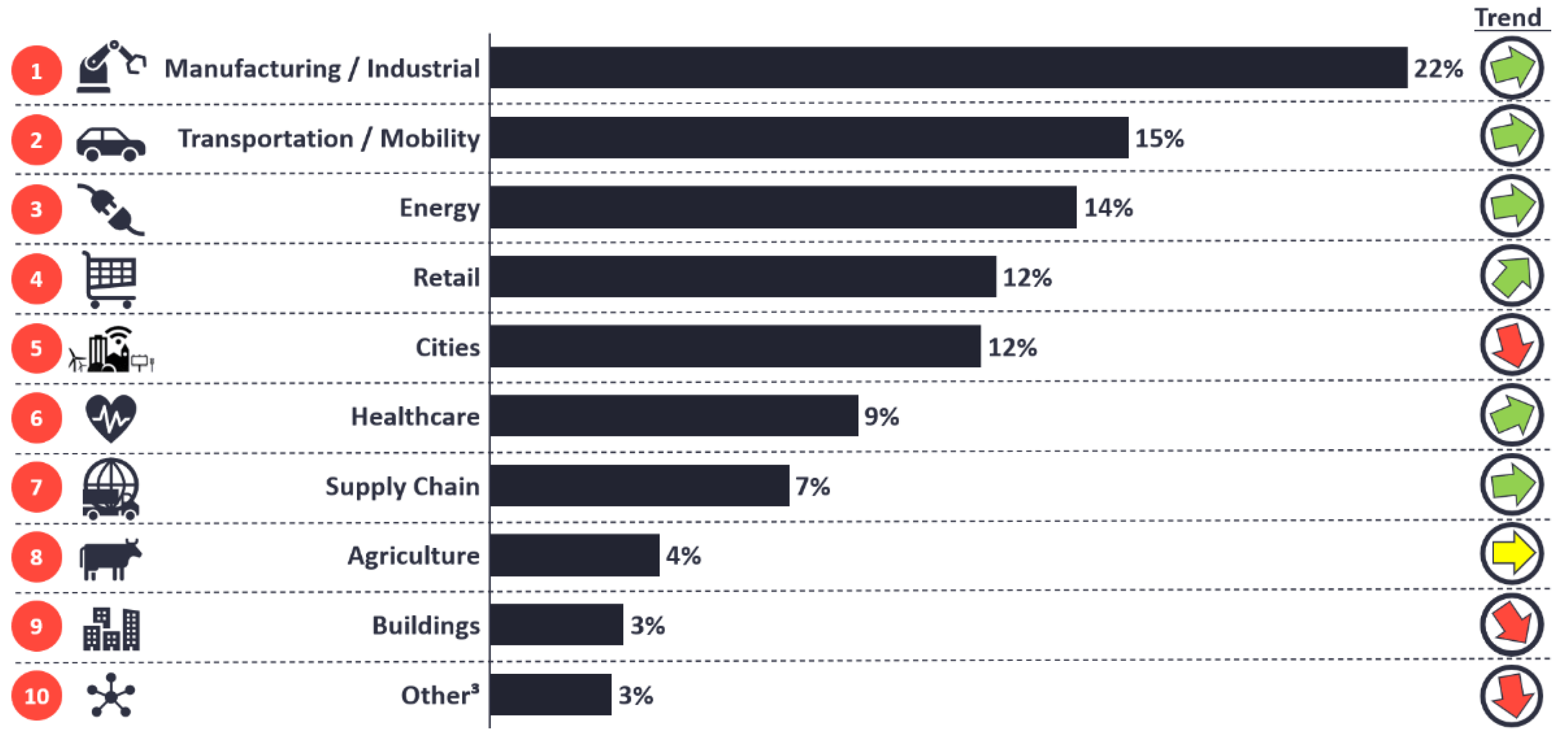
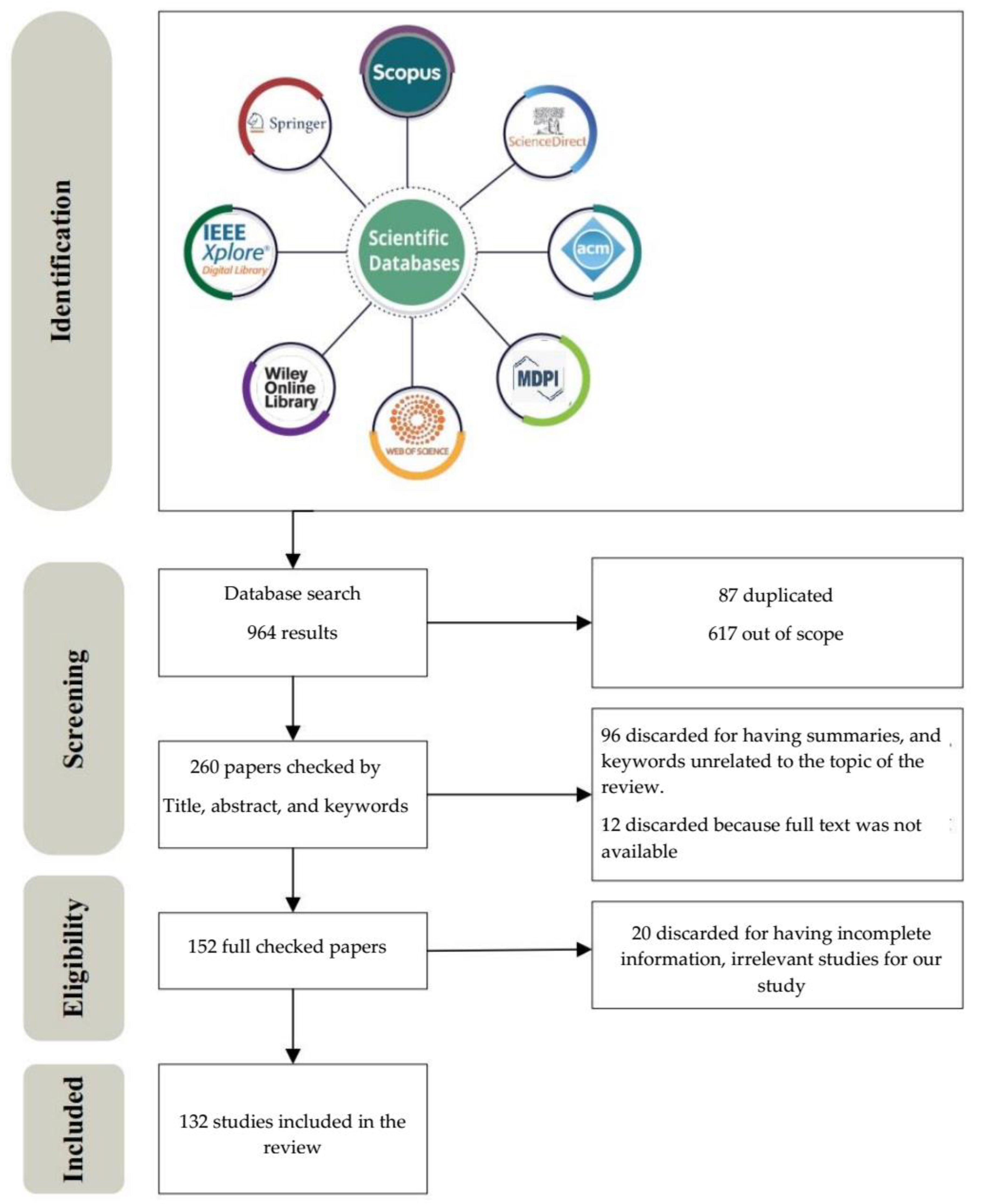


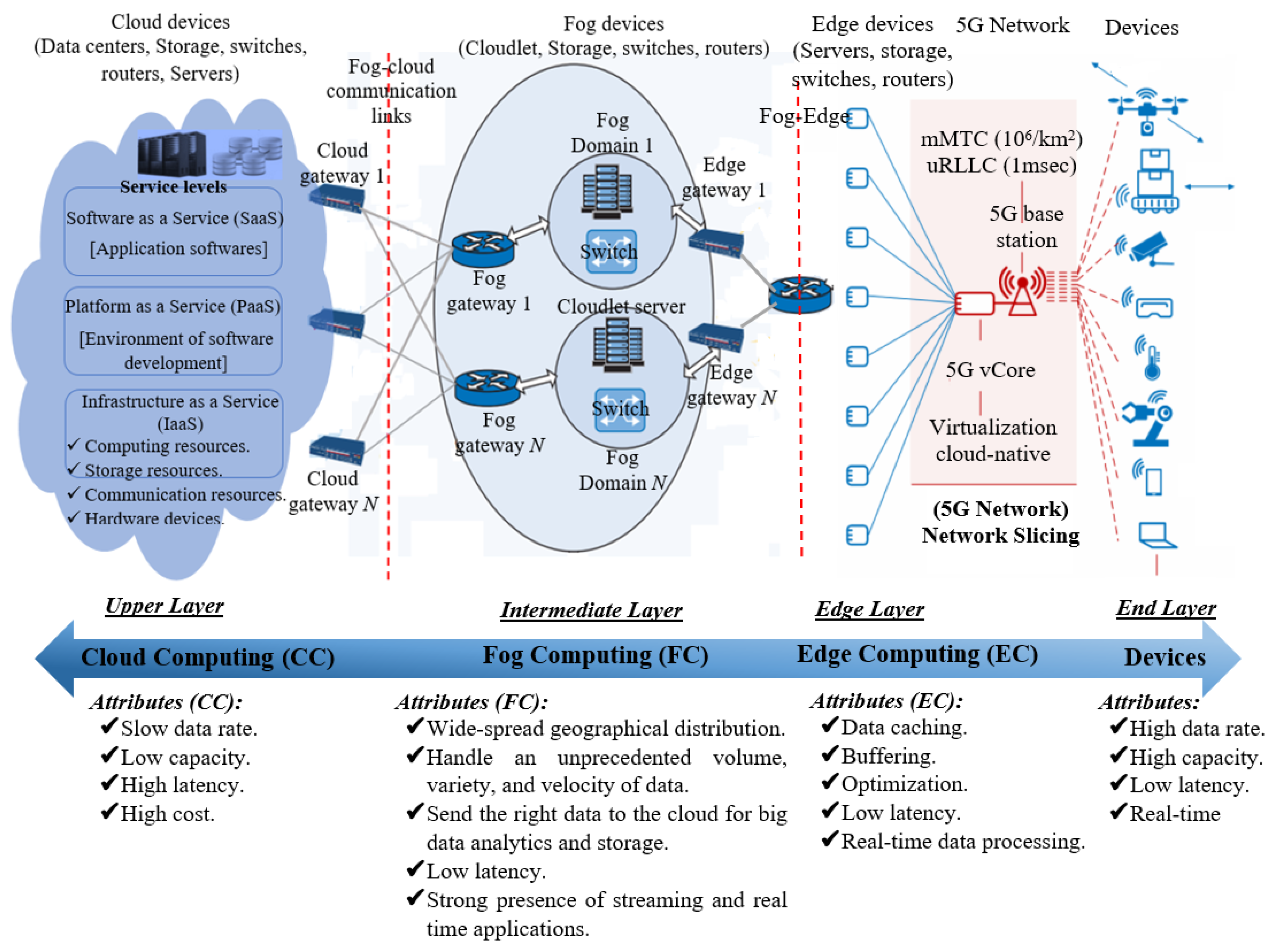
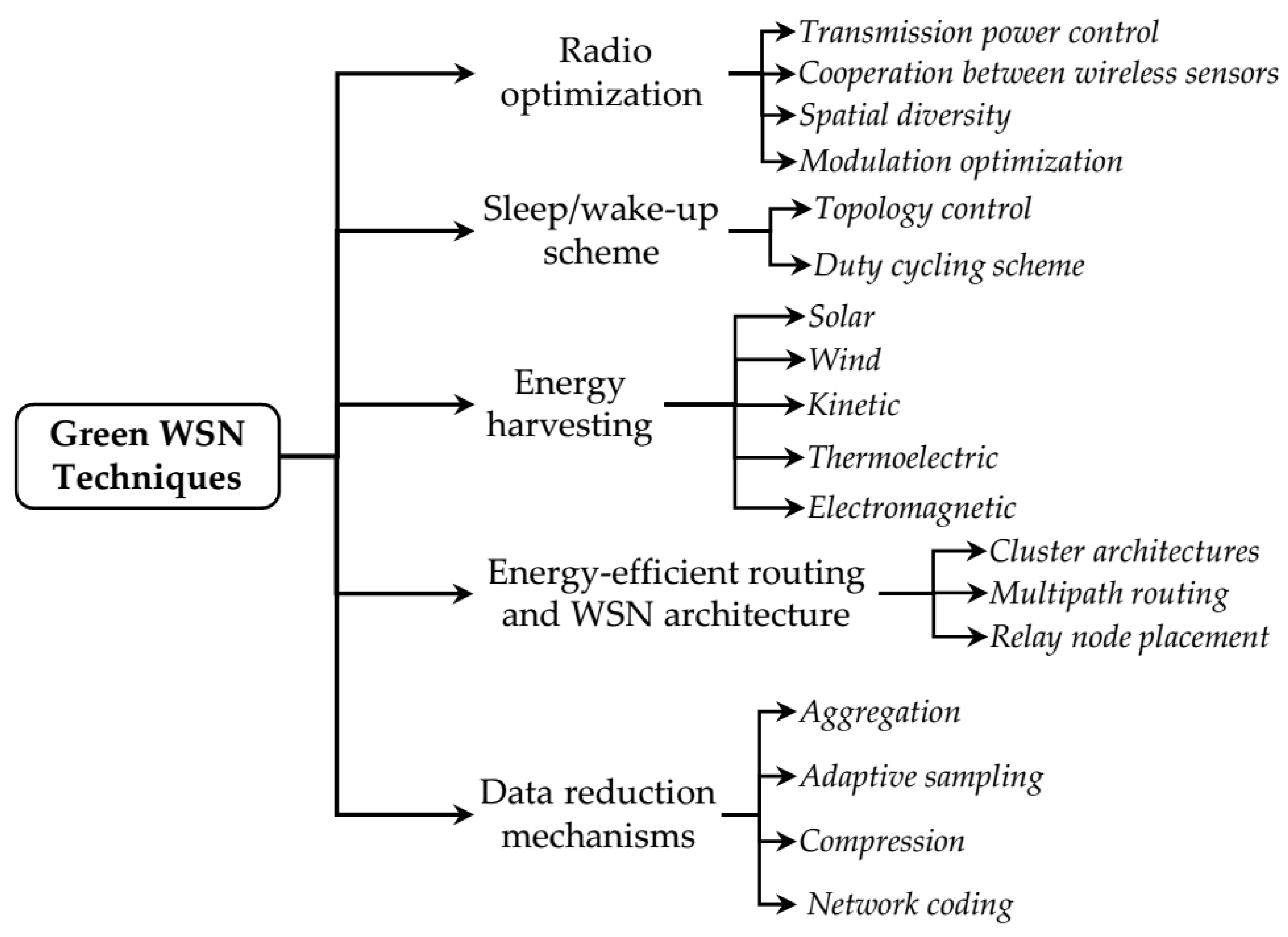
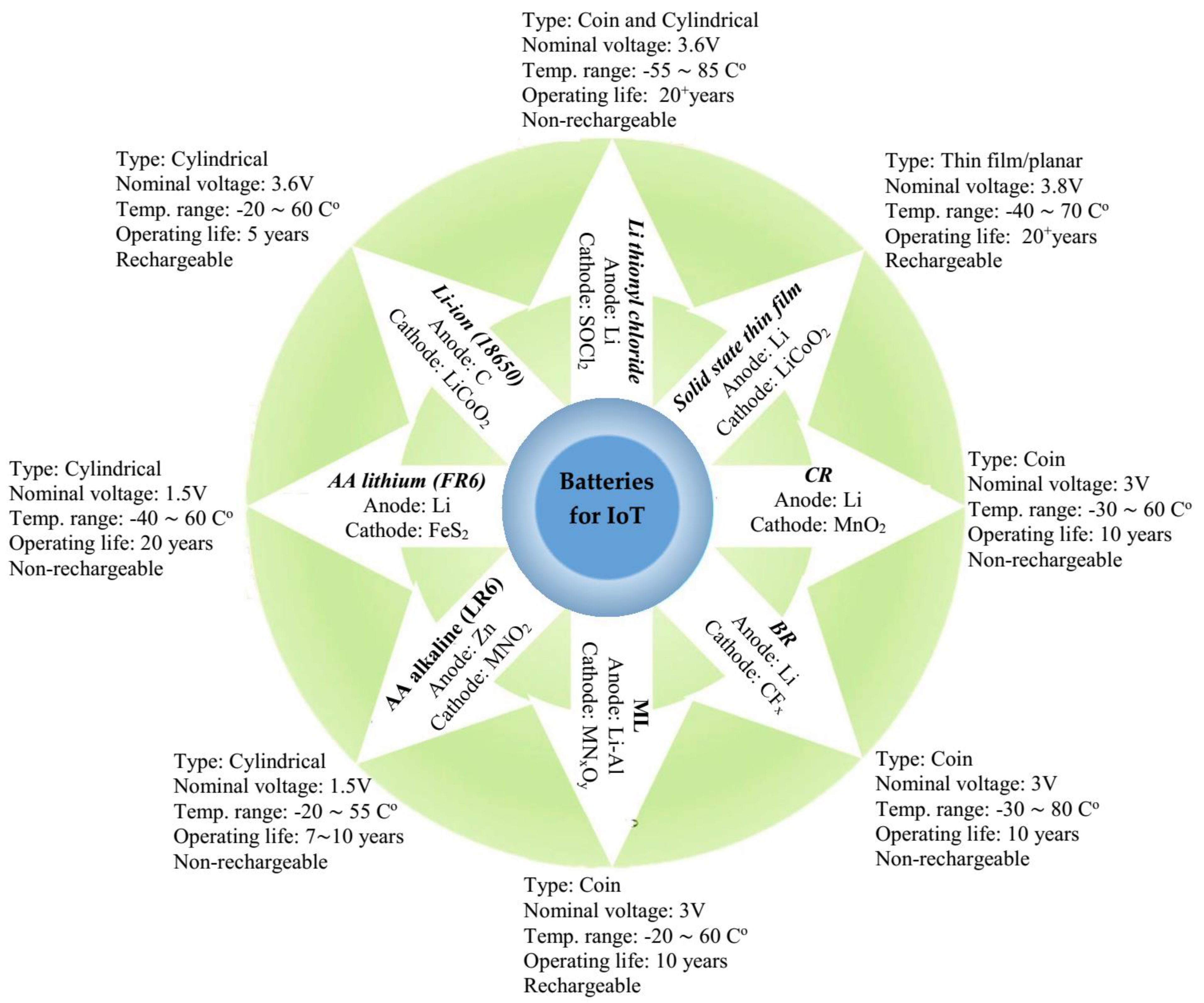


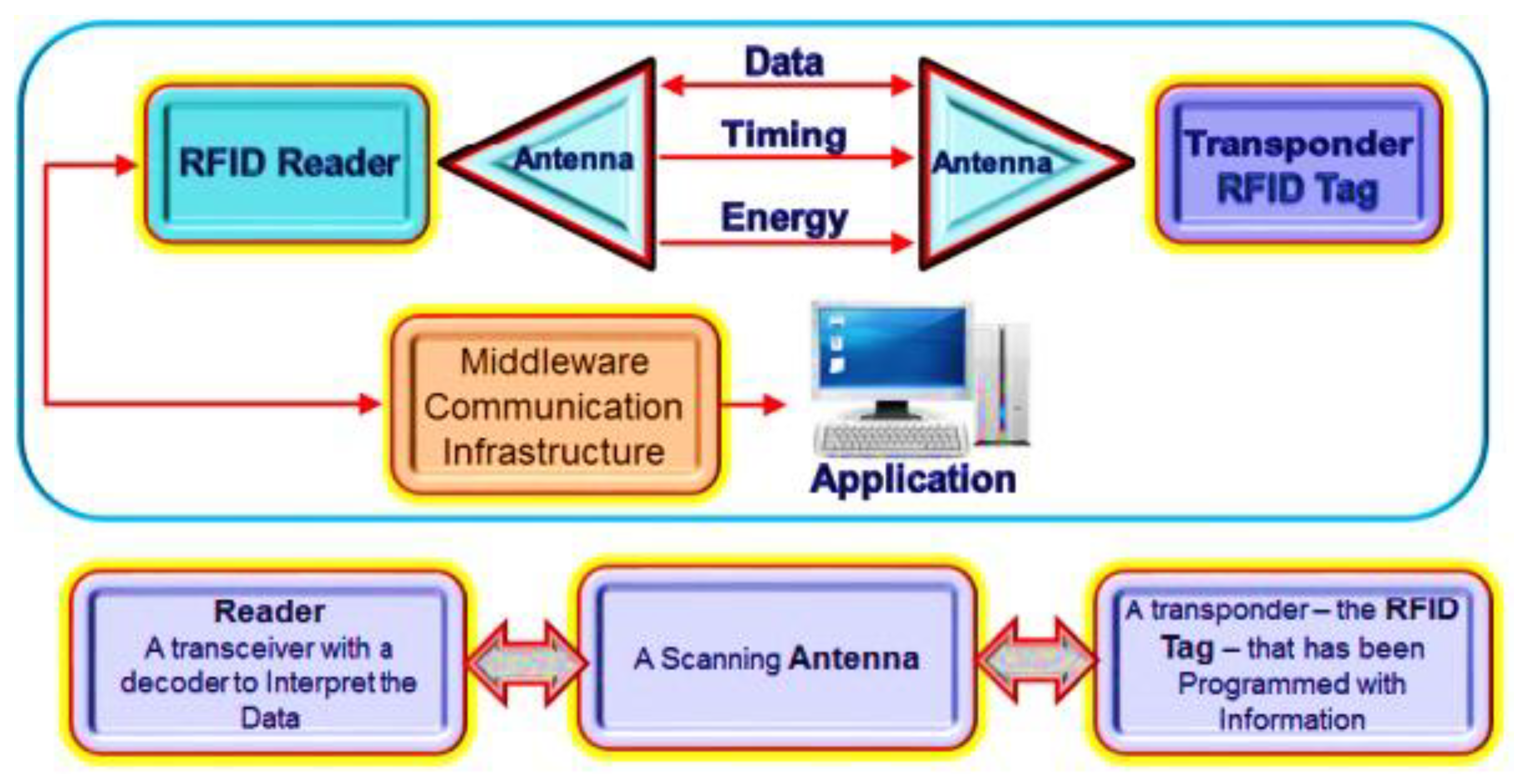
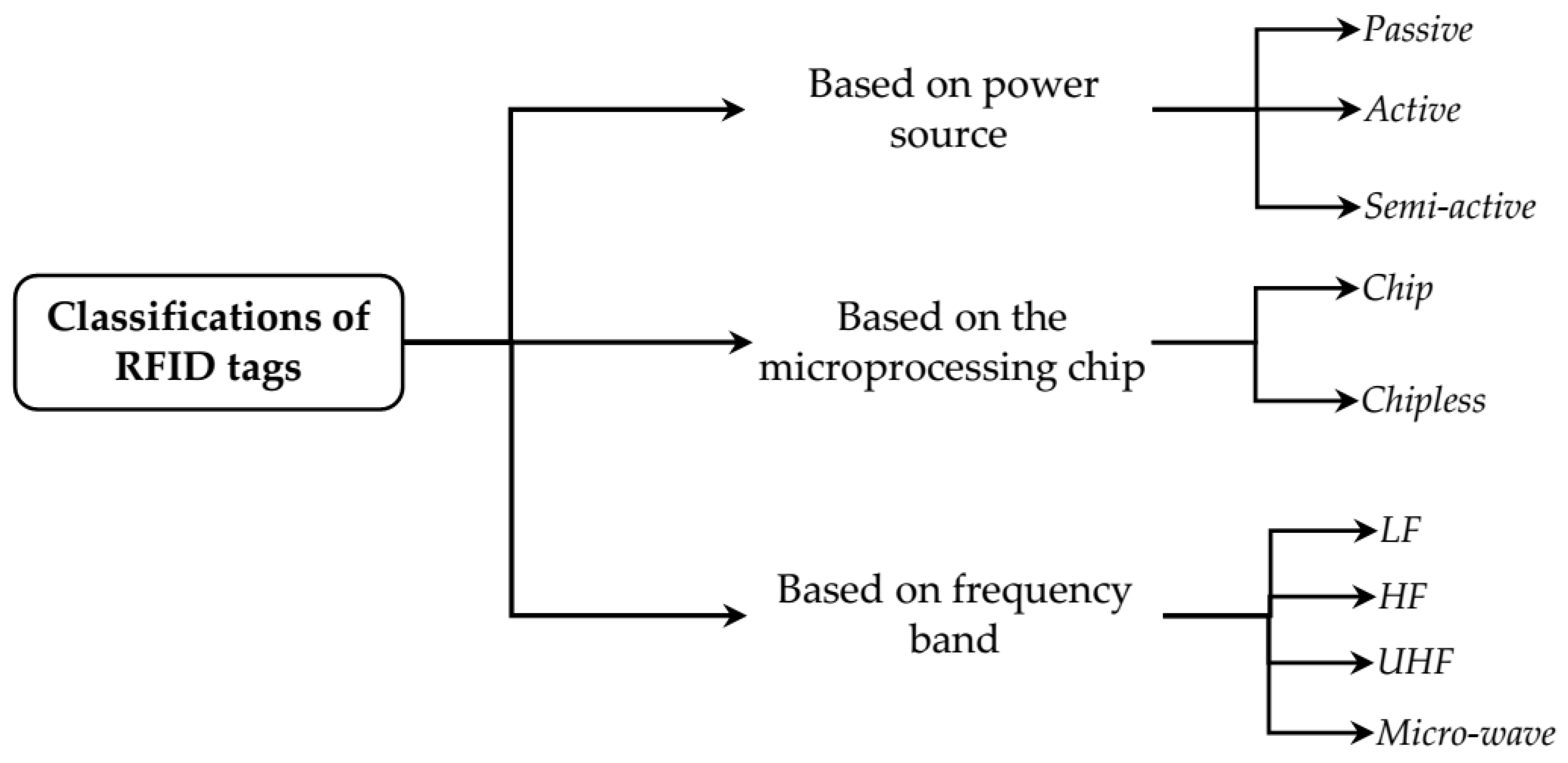


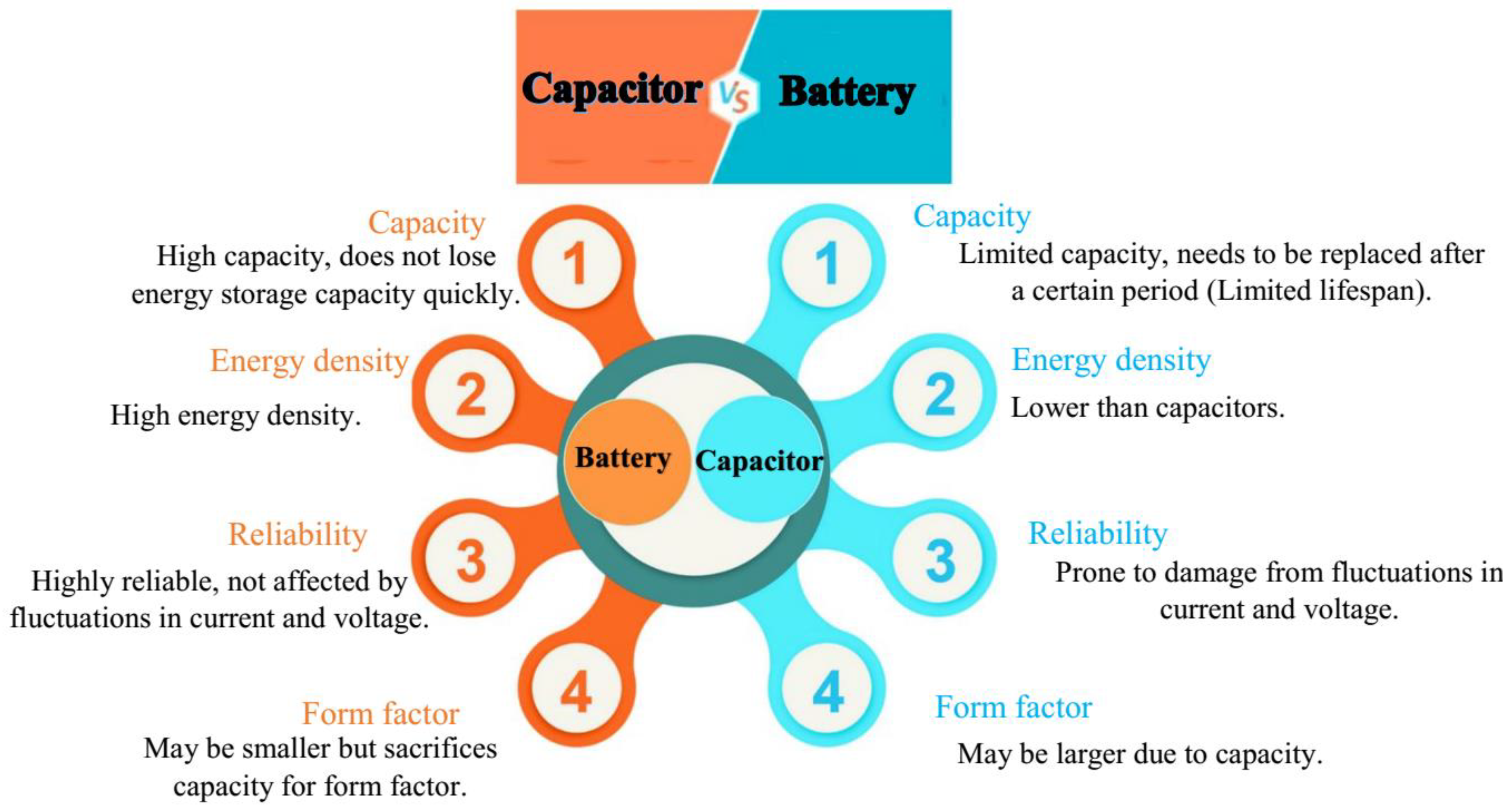


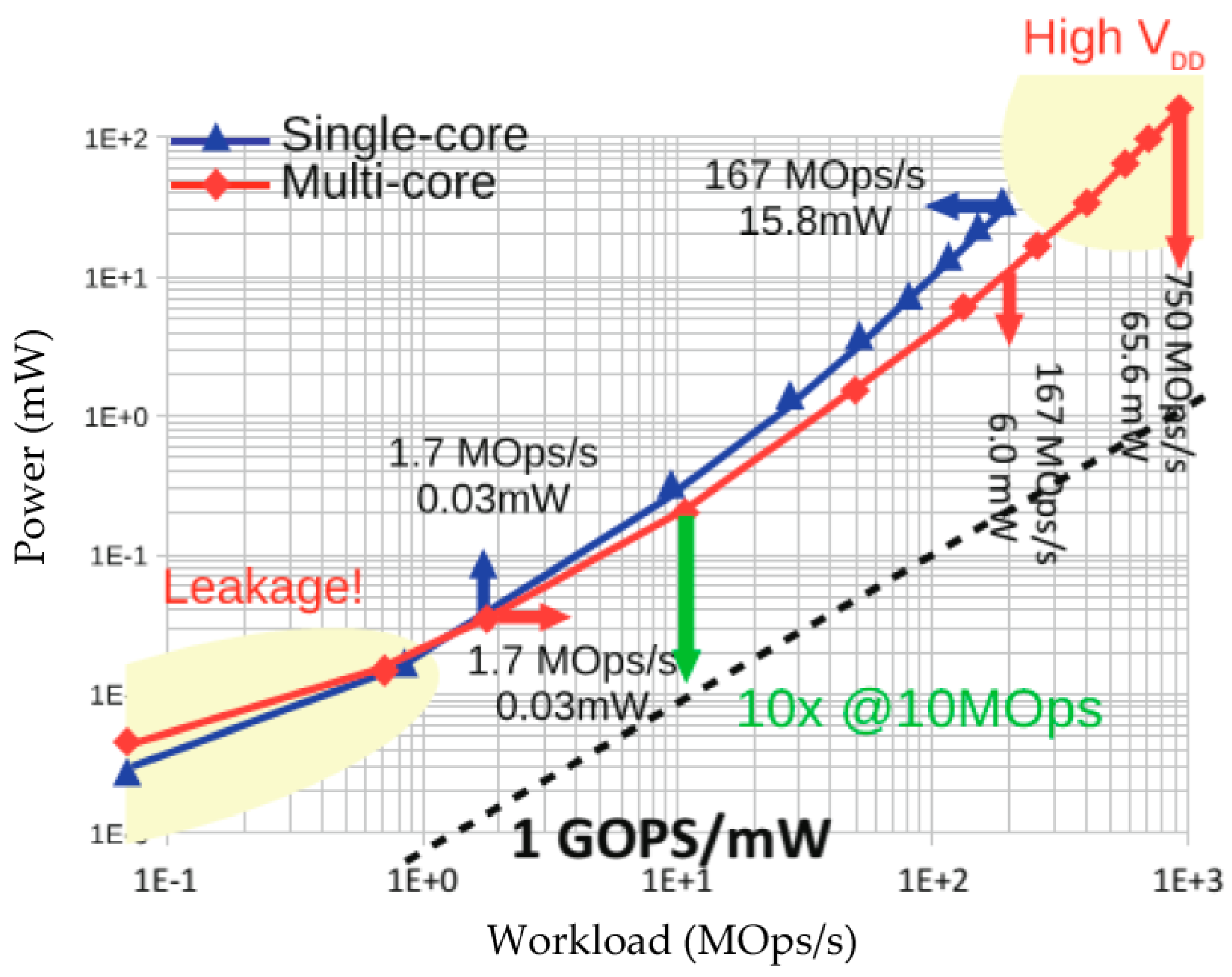

| Technique | Description | Advantages | Disadvantages |
|---|---|---|---|
| Huffman coding | Lossless data compression algorithm that encodes data using a variable-length prefix code based on character frequencies. |
|
|
| Lempel-Ziv-Welch (LZW) algorithm | Encodes data by identifying and replacing repeated patterns with references. |
|
|
| Run-length encoding (RLE) | A technique that reduces data size by replacing repeated characters with a single character and a count of their occurrences. |
|
|
| Delta encoding | Encodes data by representing the difference between successive values rather than the values themselves. |
|
|
| Predictive coding | A technique that predicts values and encodes the difference between the prediction and actual value. |
|
|
| Transform coding | Uses a mathematical transformation to convert the data into a different domain, where it can be more efficiently encoded. |
|
|
| Parameters | LoRa | Bluetooth | LR-WPAN | Mobile Communication | WiMAX | WiFi |
|---|---|---|---|---|---|---|
| Standard | LoRaWAN R1.0 | IEEE 802.15.1 | IEEE 802.15.4 (ZigBee) | 2G-GSM, CDMA 3G-UMTS, CDMA2000 4G-LTE-A | IEEE 802.16 | IEEE 802.11 a/c/b/d/g/n |
| Energy consumption | Very Low | Bluetooth: Medium; BLE: Very Low | Low | Medium | Medium | High |
| Frequency band | 868/900 MHz | 2.4 GHz | 868/915 MHz, 2.4 GHz | 865 MHz–2.6 GHz | 2–66 GHz | 5–60 GHz |
| Data rate | 0.3–50 Kb/s | 1–24 Mb/s | 40–250 Kb/s | 200 kb/s–1 Gb/s | 1 Mb/s–1 Gb/s (Fixed) 50–100 Mb/s (mobile) | 1 Mb/s–6.75 Gb/s |
| Transmission range | <30 Km | 8–10 m | 10–20 m | Entire cellular area | <50 Km | 20–100 m |
| Cost | High | Low | Low | Medium | High | High |
| Wireless Technology | Healthcare | Smart Cities | Smart Building | Automotive | Industry | Local Network (M2M) |
|---|---|---|---|---|---|---|
| Bluetooth (BLE) | very high | low | low | very low | very high | medium |
| LR-WPAN | medium | high | low | very low | low | high |
| LoRa | low | high | high | high | high | high |
| WiFi | low | high | medium | medium | low | high |
| WiMAX | low | very high | high | high | very high | high |
| Mobile communication | low | high | high | high | medium | very low |
| Environment | Power Harvester | |||
|---|---|---|---|---|
| Solar panel | Wind generator | Thermoelectric | Electromagnetic | |
| Power density of the indoor environment | 100 µW/cm2 | 35 µW/cm2 @ wind speed < 1 m/s | 100 µW/cm2 @ 5 °C | 4 µW/cm3 @ human motion (Hz) 800 µW/cm3 @ machine (kHz) |
| Power density of the outdoor environment | 10 mW/cm2 | 3.5 mW/cm2 @ wind speed ≤ 8.4 m/s | 3.5 mW/cm2 @ 30 °C | |
| Technique | Advantages | Disadvantages | Charging Distance |
|---|---|---|---|
| Magnetic inductive coupling |
|
| Near-field. |
| Magnetic resonance coupling |
|
| Near-field. |
| Non-directive RF radiation |
|
| Far-field. |
| Energy-Efficient Technique | Energy Savings | Advantages | Disadvantages | |
|---|---|---|---|---|
| Radio Optimization Techniques | Transmission power control: Dynamic adjustment of transmission power to minimize energy consumption [46,88,89]. | Up to 50% compared to a constant transmission power approach. |
|
|
| Cooperation between wireless sensors: Collaborative data processing, routing, and sharing among neighboring sensors [89,90]. | Up to 80% compared to independent sensor operation. |
|
| |
| Spatial diversity: Involves using multiple antennas to transmit the same signal from different locations, which can reduce the transmission power required to achieve the same level of communication performance, leading to energy savings [91,92]. | 20–50% |
|
| |
| Modulation optimization: Adjusts the modulation scheme based on the channel conditions and distance between nodes to reduce the energy consumption of transmissions while maintaining acceptable levels of communication performance [50,93]. | Up to 60% |
|
| |
| Sleep/Wake-up Techniques | Topology control: Adjusting the transmission range; nodes can avoid unnecessary communication and reduce energy consumption [90,94,95]. | 15–60% |
|
|
| Duty cycling: In which a sensor node is put into sleep mode for a certain period of time, known as the “duty cycle”. During this sleep period, the node does not transmit or receive data, and its radio is turned off. When the sleep period ends, the node wakes up and resumes its normal operations [92,96,97]. | 30–50% |
|
| |
| Energy Harvesting Techniques [92,98,99]. | Solar | 70–90% |
|
|
| Wind | 10–20% |
|
| |
| Kinetic | 20–40% |
|
| |
| Thermoelectric | 5–10% |
|
| |
| Electromagnetic | 5–10% |
|
| |
| Architecture and Routing Protocols [100,101,102]. | Cluster architecture | 20–40% |
|
|
| Multipath routing | 20–30% |
|
| |
| Relay node placement | 30–50% |
|
| |
| Data Reduction Techniques [92,103,104]. | Aggregation | 20–80% |
|
|
| Adaptive sampling | 30–60% |
|
| |
| Compression | 50–90% |
|
| |
| Network coding | 30–70% |
|
| |
| Processor | MSP430 | ReiSC | TMS320C64x | FRISBEE | ARM CortexM3 | OpenRISC | |
|---|---|---|---|---|---|---|---|
| Feature | |||||||
| Number of cores | 1 | 1 | 1 | 1 | 64 | 4 | |
| Data format | 16-bit | 32-bit | 32-bit VLIW | 32-bit VLIW | 32-bit | 32-bit | |
| Technology | CMOS | CMOS | CMOS | FD-SOI | CMOS | FD-SOI | |
| VDD range (V) | 0.4 (1.0) | (0.4–1.2) | 0.6–1.0 | 0.4–1.3 | 0.65–1.15 | 0.32–1.2 | |
| Max freq. (MHz) | 25 | 82.5 | 331 | 2600 | 80 | 825 | |
| Power dens. (µW/MHz) | 7.7 | 10.2 | 409 | 62 | 317 | 20.7 | |
| Best Perf. (MOPS) | 25 | 57.5 | 662 | 2600 | 1600 | 3300 | |
| Energy eff. (MOPS/ mW) | 64.5 | 68.6 | 4.5 | 16 | 3.9 | 193 | |
Disclaimer/Publisher’s Note: The statements, opinions and data contained in all publications are solely those of the individual author(s) and contributor(s) and not of MDPI and/or the editor(s). MDPI and/or the editor(s) disclaim responsibility for any injury to people or property resulting from any ideas, methods, instructions or products referred to in the content. |
© 2023 by the authors. Licensee MDPI, Basel, Switzerland. This article is an open access article distributed under the terms and conditions of the Creative Commons Attribution (CC BY) license (https://creativecommons.org/licenses/by/4.0/).
Share and Cite
Alsharif, M.H.; Jahid, A.; Kelechi, A.H.; Kannadasan, R. Green IoT: A Review and Future Research Directions. Symmetry 2023, 15, 757. https://doi.org/10.3390/sym15030757
Alsharif MH, Jahid A, Kelechi AH, Kannadasan R. Green IoT: A Review and Future Research Directions. Symmetry. 2023; 15(3):757. https://doi.org/10.3390/sym15030757
Chicago/Turabian StyleAlsharif, Mohammed H., Abu Jahid, Anabi Hilary Kelechi, and Raju Kannadasan. 2023. "Green IoT: A Review and Future Research Directions" Symmetry 15, no. 3: 757. https://doi.org/10.3390/sym15030757
APA StyleAlsharif, M. H., Jahid, A., Kelechi, A. H., & Kannadasan, R. (2023). Green IoT: A Review and Future Research Directions. Symmetry, 15(3), 757. https://doi.org/10.3390/sym15030757









